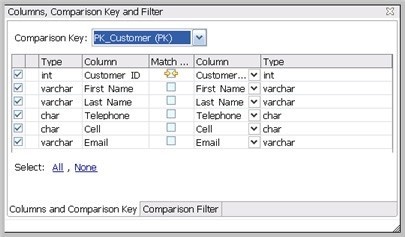Page History
...
After comparing the data, you can synchronize it to match; . For more information about this feature, see Synchronizing Data Repositories.
...
You create, modify, and run a Data Comparison job in the Data Comparison Job editor. For more details about the editor, see Data Comparison Job Editor in the User Interface Reference.
To create a new data comparison job
...
If the job will be used to monitor compliance against company standards or policies, you can add it to the Compliance Explorer list. This list lets you quickly see all the jobs that have recently passed or failed the compliance criteria you set.
...
- Type a new name for the job in the Name field. Enter a meaningful name that will quickly and uniquely identify the job in other views and dialogs.
- Add relevant information in the Notes field.
- Click Track Results in Compliance Explorer if you want the job to be listed in the Compliance Explorer. Compliance is used most commonly for configuration comparisons.
- Click File > Save or File > Save All, or highlight the editor window and press Ctrl+S.
...
Click and drag a data source from Data Source Explorer to the Data Comparison Source or Data Comparison Target box, or click Select Data Source in the appropriate box and choose a data source from the dialog.
Info You can change a data source selection by clicking Change Data Source from the appropriate box, or by dragging a different data source to the box from Data Source Explorer.
- Select the databases, or tables and views (depending on the type of database), from the Databases pulldown menu.
- After you name the job and specify the data sources, click Options.
| Anchor | ||||
|---|---|---|---|---|
|
You can set various options that control how a job is processed on the Options tab.
...
- Scroll down to see all the options and their descriptions, and select or deselect them as needed.
- If an option is not available for the data source, the check box is greyed out. The options are described in the DB Change Manager Preferences Reference:
- When you are satisfied with the options, click Mapping.
...
Mapping details are shown on the Mapping tab of the editor.
| Anchor | ||||
|---|---|---|---|---|
|
When you first click into the Mapping tab, the Database Mapping table lists the two data sources and lists all of their databases. If you previously selected a database in the Overview tab, it is selected. You can scroll right to see the Last Inspected column, which indicates that the pair has not yet been analyzed, or inspected, by DB Change Manager. The right side of the pane provides similar information.
...
- Select a row by highlighting it with the cursor. (The check box is irrelevant for this task.)
- On the right side of the pane, click View Column Mapping.
- In the Columns and Comparison Key pane, you can:
- Select or deselect columns to use in the comparison job. Because this could affect referential integrity, review Resolution Options.
- Change or add a comparison key if multiple keys are available. In the Comparison Filter pane, you can:
- Write a WHERE clause to use during the comparison.
Create a different WHERE clause per table in the pair. Select Separate Where Clause and an additional text box is added for a second WHERE clause.
Info When entering selective WHERE clauses, do not include the WHERE keyword; for example, use “AGE>12” instead of “WHERE AGE>12”.
...
In the Options tab, select or deselect Mapping Options. The options are also described in Mapping Options.
Info If you change the mapping options in Preferences, they will become the defaults for all new jobs.
- In the Mapping tab, click Refresh Databases and Owners to update the automatic comparison.
...
- Source and target data source names
- When the job started
- Estimated remaining time for the job to run
- Elapsed time of the job
- Names of objects currently being compared
- A progress bar showing percentage completion
| Anchor | ||||
|---|---|---|---|---|
|
After a job run completes, the Results tab shows the Comparison Results table.
...
